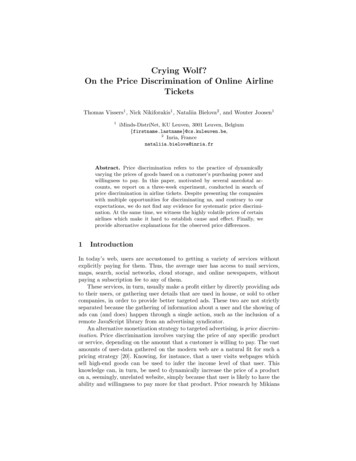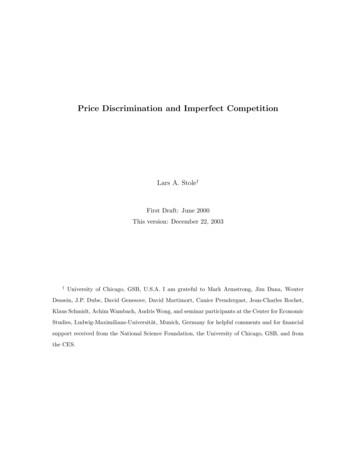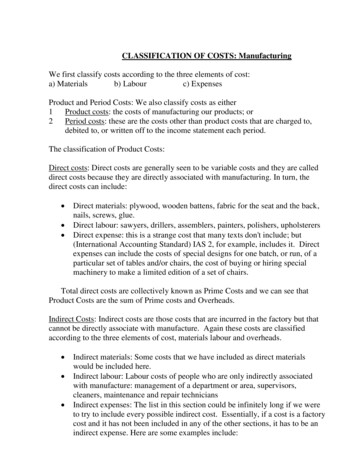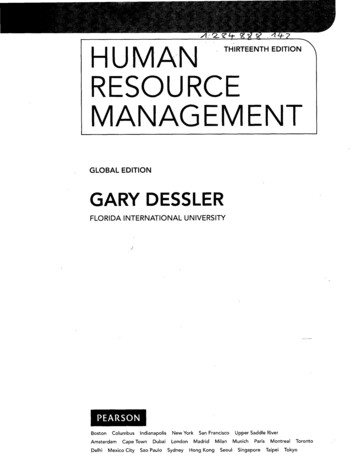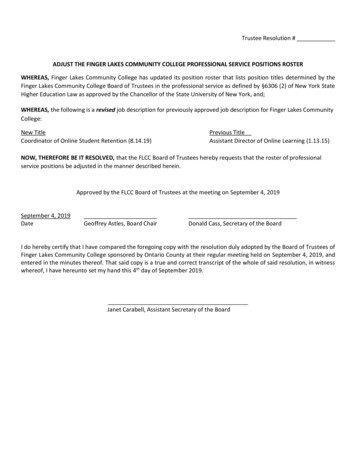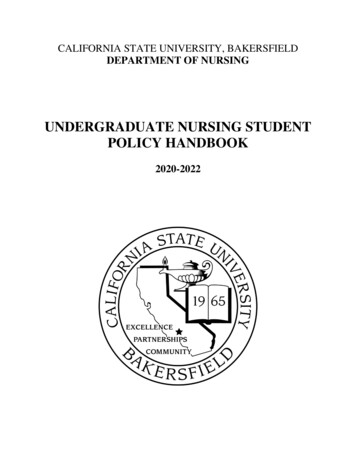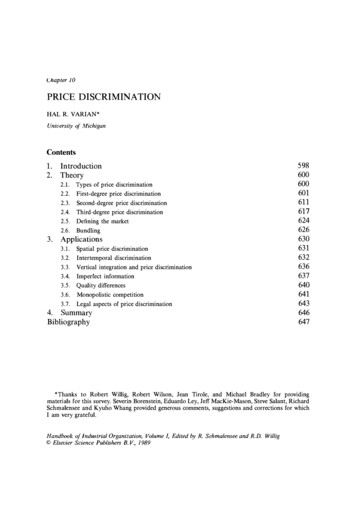
Transcription
Chapter 10PRICE DISCRIMINATIONHAL R. VARIAN*University of 2.4.2.5.2.6.Types of price discriminationFirst-degree price discriminationSecond-degree price discriminationThird-degree price discriminationDefining the marketBundling3.1.3.2.3.3.3.4.3.5.3.6.3.7.Spatial price discriminationIntertemporal discriminationVertical integration and price discriminationImperfect informationQuality differencesMonopolistic competitionLegal aspects of price discrimination3. Applications4. 32636637640641643646647*Thanks to Robert Willig, Robert Wilson, Jean Tirole, and Michael Bradley for providingmaterials for this survey. Severin Borenstein, Eduardo Ley, Jeff MacKie-Mason, Steve Salant, RichardSchmalensee and Kyuho Whang provided generous comments, suggestions and corrections for whichI am very grateful.Handbook of Industrial Organization, Volume I, Edited by R. Schmalensee and R.D. Willig Elsevier Science Publishers B. V., 1989
598H.R. Varian1. IntroductionPrice discrimination is one of the most prevalent forms of marketing practices.One may occasionally doubt whether firms really engage in some of the kinds ofsophisticated strategic reasoning economists are fond of examining, but there canbe no doubt that firms are well aware of the benefits of price discrimination.Consider, for example, the following passage taken from a brochure publishedby the Boston Consulting Group:A key step is to avoid average pncmg. Pricing to specific customer groupsshould reflect the true competitive value of what is being provided. When thisis achieved, no money is left on the table unnecessarily on the one hand, whileno opportunities are opened for competitors though inadvertent overpricing onthe other. Pricing is an accurate and confident action that takes full advantageof the combination of customers' price sensitivity and alternative suppliersthey have or could have [Miles (1986)].Although an economist might have used somewhat more technical terminol ogy, the central ideas of price discrimination are quite apparent in this passage.Every undergraduate microeconomics textbook contains a list of examples ofprice discrimination; the most popular illustrations seem to be those of studentdiscounts, Senior Citizen's discounts, and the like. Given the prevalence of pricediscrimination as an economic phenomenon, it is surprisingly difficult to come upwith an entirely satisfactory definition.The conventional definition is that price discrimination is present when thesame commodity is sold at different prices to different consumers. However, thisdefinition fails on two counts: different prices charged to different consumerscould simply reflect transportation costs, or similar costs of selling the good; andprice discrimination could be present even when all consumers are charged thesame price - consider the case of a uniform delivered price. 1We prefer Stigler's (1987) definition: price discrimination is present when twoor more similar goods are sold at prices that are in different ratios to marginalcosts. As an illustration, Stigler uses the example of a book that sells in hardcover for 15 and in paperback for 5. Here, he argues, there is a presumption of1For further discussion, see Phlips (1983, pp. 5-7).
Ch. I 0: Price Discrimination599discrimination, since the binding costs are not sufficient to explain the differencein price. Of course, this definition still leaves open the precise meaning of"similar", but the definition will be useful for our purposes.Three conditions are necessary in order for price discrimination to be a viablesolution to a firm's pricing problem. First, the firm must have some marketpower. Second, the firm must have the ability to sort customers. And third, thefirm must be able to prevent resale. We will briefly discuss each of these points,and develop them in much greater detail in the course of the chapter.We turn first to the issue of market power. Price discrimination arises naturallyin the theory of monopoly and oligopoly. Whenever a good is sold at a price inexcess of its marginal cost, there is an incentive to engage in price discrimination.For to say that price is in excess of marginal cost is to say that there is someonewho is willing to pay more than the cost of production for an extra unit of thegood. Lowering the price to all consumers may well be unprofitable, but loweringthe price to the marginal consumer alone will likely be profitable.In order to lower the price only to the marginal consumer, or more generally tosome specific class of consumers, the firm must have a way to sort consumers.The easiest case is where the firm can explicitly sort consumers with respect tosome exogenous category such as age. A more complex analysis is necessary whenthe firm must price discriminate on the basis of some endogenous category suchas time of purchase. In this case the monopolist faces the problem of structuringhis pricing so that consumers "self-select" into appropriate categories.Finally, if the firm is to sell at different prices to different consumers, the firmmust have a way to prevent consumers who purchase at a discount price fromreselling to other consumers. Carlton and Perloff (forthcoming) discuss severalmechanisms that can be used to prevent resale: Some goods such as services, electric power, etc. are difficult to resell because ofthe nature of the good. Tariffs, taxes and transportation costs can impose barriers to resale. Forexample, it is common for publishers to sell books at different prices indifferent countries and rely on transportation costs or tariffs to restrict resale. A firm may legally restrict resale. For example, computer manufacturers oftenoffer educational discounts along with a contractual provision that restrictsresale A firm can modify its product. For example, some firms sell student editions ofsoftware that has more limited capabilities than the standard versions.The economic analyst is, of course, interested in having a detailed and accuratemodel of the firm's behavior. But in addition, the economist wants to be able topass judgment on that behavior. To what degree does price discrimination ofvarious types promote economic welfare? What types of discrimination should beencouraged and what types discouraged? Price discrimination is illegal only
600H.R. Varianinsofar as it "substantially lessens competition". How are we to interpret thisphrase? These are some of the issues we will examine in this survey.2. Theory2.1. Types of price discriminationThe traditional classification of the forms of price discrimination is due to Pigou(1920).First-degree, or perfect price discrimination involves the seller charging adifferent price for each unit of the good in such a way that the price charged foreach unit is equal to the maximum willingness to pay for that unit.Second-degree price discrimination, or nonlinear pricing, occurs when pricesdiffer depending on the number of units of the good bought, but not acrossconsumers. That is, each consumer faces the same price schedule, but theschedule involves different prices for different amounts of the good purchased.Quantity discounts or premia are the obvious examples.Third-degree price discrimination means that different purchasers are chargeddifferent prices, but each purchaser pays a constant amount for each unit of thegood bought. This is perhaps the most common form of price discrimination;examples are student discounts, or charging different prices on different days ofthe week.We will follow Pigou's classification in this survey, discussing the forms ofprice discrimination in the order in which he suggested them. Subsequently, wewill take up some more specialized topics that do not seem to fit conveniently inthis classification scheme.We have had the benefit of a number of other surveys of the topic of pricediscrimination and have not hesitated to draw heavily from those works. Some ofthese works are published and some are not, and it seems appropriate to brieflysurvey the surveys before launching in to our own.First, we must mention Phlips' (1983) extensive book, The Economics of PriceDiscrimination, which contains a broad survey of the area and many intriguingexamples. Next, we have found Tirole's (1988) chapter on price discrimination tobe very useful, especially in its description of issues involving nonlinear pricing.Robert Wilson's class notes (1985) provided us with an extensive bibliographyand discussion of many aspects of product marketing, of which price discrimina tion is only a part. Finally, Carlton and Perloff (forthcoming) give a very niceoverview of the issues and a detailed treatment of several interesting sub-topics.We are especially grateful to these authors for providing us with their unpub lished work.
Ch. I 0: Price Discrimination6012.2. First-degree price discriminationFirst-degree price discrimination, or perfect price discrimination, means that theseller sells each unit of the good at the maximum price that anyone is willing topay for that unit of the good. Alternatively, perfect price discrimination issometimes defined as occurring when the seller makes a single take-it-or-leave-itoffer to each consumer that extracts the maximum amount possible from themarket.Although the equivalence of these two definitions has been long asserted - Pigoumentions it in his discussion of first-degree price discrimination - it is not entirelyclear just how generally the two definitions coincide. Is the equivalence true onlyin the case of quasilinear utility, or does it hold true more generally? As it turnsout, the proposition is valid in quite general circumstances.To see this, consider a simple model with two goods, x and y and a singleconsumer. We choose y as the numeraire good, and normalize its price to one.(Think of the y-good as being money.) The consumer is initially consuming 0units of the x-good, and the monopolist wishes to sell x* units for the largestpossible amount of the y-good. Let y* be the amount of the y-good that theconsumer has after making this payment; then y* is the solution to the equationu(x*,y*) u(O, y),(1)and the payment is simply y - y*. This is clearly the largest possible amount ofthe y-good that the consumer would pay on a take-it-or-leave-it basis to consumex* units of the x-good.Suppose instead that the monopolist breaks up x* into n pieces of size L1x andsells each piece to the consumer at the maximum price the consumer would bewilling to pay for that piece. Let (x;, y;) be the amount the consumer has at theith stage of this process, so that thus Y; i - Y; is the amount paid for the ith unitof the x-good. Since utility remains constantduring this process we haveu(x 1 , Yi ) - u(O, y) 0,(2)We want to show that Yn , the total amount held of the y-good after this processis completed, is equal to y*, the amount paid by the take-it-or-leave-it offerdescribed above.
602H.R. VarianBut this is easy; just add up the equations in (2) to findu(x*, y,,) - u(O, y) 0.Examining (1) we see that y,, y*, as was to be shown.2.2.1. Welfare and output effectsIt is well known that a perfectly discriminating monopolist produces a Paretoefficient amount of output, but a formal proof of this proposition may beinstructive. Let u(x, y) be the utility function of the consumer, as before, and forsimplicity suppose that the monopolist cares only about his consumption of they-good. (Again, it is convenient to think of the y-good as being money.) Themonopolist is endowed with a technology that allows him to produce x units ofthe x-good by using c(x) units of the y-good. The initial endowment of theconsumer is denoted by (x e, Ye ), and by assumption the monopolist has an initialendowment of zero of each good.The monopolist wants to choose a (positive) production level x and a (nega tive) payment y of the y-good that maximizes his utility subject to the constraintthat the consumer actually purchases the x-good from the monopolist. Thus, themaximization problem becomes:maxy - c(x)x, ys.t. u(x e X,Ye - Y) u(x e , yJ.But this problem simply asks us to find a feasible allocation that maximizes theutility of one party, the monopolist, subject to the constraint that the other party,the consumer, has some given level of utility. This is the definition of a Paretoefficient allocation. Hence, a perfectly discriminating monopolist will choose aPareto efficient level of output.By the Second Welfare Theorem, and the appropriate convexity conditions,this Pareto efficient level of output is a competitive equilibrium for someendowments. In order to see this directly, denote the solution to the monopolist'smaximization problem by (x*, y*). This solution must satisfy the first-orderconditions:1 - "ll.- c'(x*) A3u(x e x*, Ye - y*)ay3u(x e x *, Ye - y*)ax 0, 0.(3)
Ch. 10: Price Discrimination603Dividing the second equation by the first and rearranging gives us:au (xe x*, Ye - y*) /ax-------- c' (x*) .au (xe x*, Ye - y* ) /ayIf the consumer has an endowment of (xe x*, Ye y*) and the firm faces aparametric price set atau (xe x*, Ye - y* ) /axp* - ------au (x e x*, Ye - y* ) /ay 'the firm's profit maximization problem will take the form:max p*x - c(x) .XIn this case it is clear that the firm will optimally choose to produce x* units ofoutput, as required.Of course, the proof that the output level of a perfectly discriminatingmonopolist is the same as that of a competitive firm only holds if the appropriatereassignment of initial endowments is made. However, if we are willing to ruleout income effects, this caveat can be eliminated.To see this, let us now assume that the utility function for the consumer takesthe quasilinear form u(x) y. In this case au;ay 1 so the first-order condi tions given in (3) reduce toau (x e x*)--- c' (x*) .axThis shows that the Pareto efficient level of output produced by the perfectlydiscriminating monopolist is independent of the endowment of y, which is whatwe require. Clearly the amount of the x-good produced is the same as that of acompetitive firm that faces a parametric price given by p* au(xe x*)/ax.2.2.2. Prevalence of first-degree price discriminationTake-it-or-leave-it offers are not terribly common forms of negotiation for tworeasons. First, the "leave-it" threat lacks credibility: typically a seller has no wayto commit to breaking off negotiations if an offer is rejected. And once an initialoffer has been rejected, it is generally rational for the seller to continue tobargain.Second, even if the seller had a way to commit to ending negotiations, hetypically lacks full information about the buyers' preferences. Thus, the sellercannot determine for certain whether his offer will actually be accepted, and musttrade off the costs of rejection with the benefits of additional profits.
604H.R. VarianIf the seller was able to precommit to take-it-or-leave-it, and he had perfectinformation about buyers' preferences, one would expect to see transactionsmade according to this mechanism. After all, it does afford the seller the mostpossible profits.However, vestiges of the attempt to first-degree price discrimination can still bedetected in some marketing arrangements. Some kinds of goods - ranging fromaircraft on the one hand to refrigerators and stereos on the other - are still soldby haggling. Certainly this must be due to an attempt to price discriminateamong prospective customers.To the extent that such haggling is successful in extracting the full surplus fromconsumers, it tends to encourage the production of an efficient amount of output.But of course the haggling itself incurs costs. A full welfare analysis of attemptsto engage in this kind of price discrimination cannot neglect the transactionscosts involved in the negotiation itself.2.2.3. Two-part tariffsTwo-part tariffs are pricing schemes that involve a fixed fee which must be paidto consume any amount of good, and then a variable fee based on usage. Theclassic example is pricing an amusement park: one price must be paid to enterthe park, and then further fees must be paid for each of the rides. Other examplesinclude products such as cameras and film, or telephone service which requires afixed monthly fee plus an additional charge based on usage.The classic exposition of two-part tariffs in a profit maximization setting is Oi(1971). A more extended treatment may be found in Ng and Weisser (1974) andSchmalensee (1981a). Two-part tariffs have also been applied to problems ofsocial welfare maximization by Feldstein (1972), Littlechild (1975), Leland andMeyer (1976), and Auerbach and Pellechio (1978). In this survey we will focus onthe profit maximization problem.Let the indirect utility function of a consumer of type t facing a price p andhaving income y be denoted by u( p, t) y. If the price of the good is so highthat the consumer does not choose to consume it, let u( p, t) 0. The prices ofall other goods are assumed to be constant. Note that we have built in theassumption that preferences are quasilinear; i.e. that there are no income effects.This allows for the cleanest analysis of the problem. 2Let x ( p , t) be the demand for the good by a consumer of type t when theprice is p . By Roy's Identity, x( p , t) - au( p , t)/a p . Suppose that the goodcan be produced at a constant marginal cost of c per unit.2The literature on two-part tariffs seems .a bit confused about this point; some authors explicitlyexamine cases involving income effects, but then use consumer's surplus as a welfare measure. Sinceconsumers' surplus is an exact measure of welfare only in the case where income effects are absent,this procedure is a dubious practice at best.
605Ch. 10: Price DiscriminationInitially, we consider the situation where all consumers are the same type. Ifthe firm charges an entrance fee e, the consumer will choose to enter ifv(p, t) y - e y,so that the maximum entrance fee the park can charge ise v(p, t).The profit maximization problem is thenmax e (p - c)x(p, t)e,ps.t. e v(p, t).Incorporating the constraint into the objective function and differentiating withrespect to p yields:ox(p, t)ov(p, t)--- (p - c) x(p, t) O.opopSubstituting from Roy's Identity yields:- x(p, t) (p - c)ox(p, t)op x(p, t) O,which in turn simplifies to(p - c)ax(p, t) 0.opIt follows that if all the consumers are the same type, the profit maximizingpolicy is to set price equal to marginal cost and set an entrance fee that extractsall of the consumers' surplus. That is, the optimal policy is to engage infirst-degree price discrimination. This is, of course, a Pareto efficient pricingscheme.Things become more interesting when there is a distribution of types. Let F( t)denote the cumulative distribution function and /(t) the density of types.Suppose that ov(p, t)/ot 0, so that the value of the good is decreasing in t.Then if the firm charges an entrance fee e and a price p, a consumer of type twill choose to enter ifv(p, t) y - e y.
606H.R. VarianThus, for each p there will be a marginal consumer T such thate v(p,T) .Given p, the monopolist's choice of an entrance fee is equivalent to the choiceof the marginal consumer T. For any T we can denote the aggregate demand ofthe admitted consumers asTX(p, T) fo x(p, t) f(t) dt.Note carefully the notational distinction between the demand of the admittedconsumers, X(p, T ), and the demand of the marginal consumer, x(p, T ).The profit maximization problem of the monopolist ismax v(p ,T) F(T) (p - c) X(p,T) ,T, pwhich has first-order conditions:avax-F(T) (p - c) - X(p, T) 0,apPaaxavF(T)v(p,(pcT)F'(T) )ar aro.Using Roy's Identity and the fact that F' (T ) /(T ), these conditions become:ax X(p, T) 0,ap(4)axavar F(T) v(p,T) f(T) (p - c) r a 0.(5)-x(p,T) F(T) (p - c)Multiply and divide the middle term of the first equation by X/p to find:p - c ax p-x(p,T) F(T) X(p,T) --- - X(p,T) 0.p ap X(6)Let e denote the elasticity of aggregate demand of the admitted consumers sothate ax(p,r)papX(p,T) "
Ch. 10: Price Discrimination607Using this notation, we can manipulate (6) to find:x(p, T )p-c-- \ e \ 1 .X(p, T )/F(T )p(7 )Expression (7) tells us quite a bit about two-part tariffs. First, note that theexpression is a simple transformation of the ordinary monopoly pricing rule:p-c-- l e l 1.pWhen a two-part tariff is possible, the right-hand side is adjusted down by a termwhich can be interpreted as a ratio of the demand of the marginal consumer tothe demand of the average admitted consumer. When the marginal consumer hasthe same demand as the average consumer - as in the case where all consumersare identical - the optimal two-part tariff involves setting price equal to marginalcost, as we established earlier.We would normally expect that the marginal consumer would demand lessthan the average consumer; in this case, the price charged in the two-part tariffwould be greater than marginal cost. However, it is possible that the marginalconsumer would demand more than the average consumer. Imagine a situationwhere the marginal consumer does not value the good very highly, but wants toconsume a larger than average amount, i.e. v(p, T ) is small, but 1 3 v ( p, T )/3plis large. In this case, the optimal price in the two-part tariff would be less thanmarginal cost, but the monopolist makes up for it through the entrance fees.(This is an example of the famous auto salesman claim - where the firm losesmoney on every sale but makes up for it in volume - due to the entrance fee!)For more on the analytics of two-part tariffs, see the definitive treatment bySchmalensee (1981a). Schmalensee points out that two-part tariffs are essentiallya pricing problem involving two especially complementary goods - entrance tothe amusement park and the rides themselves. Viewed from this perspective it iseasy to see why one of the goods may be sold below marginal cost, or why p istypically less than the monopoly price. Schmalensee also considers much moregeneral technologies and analyzes several important subcases such as the casewhere the customers are downstream firms.2.2. 4. Welfare effects of the two-part tariffWe have already indicated that a two-part tariff with identical consumers leads toa full welfare optimum. What happens with nonidentical consumers?Welfare is given by consumers' surplus plus profits:TW(p, T) 1 v(p, t) f (t)dt (p - c) X(p, T).0
608H.R. VarianDifferentiating with respect to p and T and using Roy's Identity, yields:a w( p , T )apaxl- rx ( p , t)f ( t)dt ( p - c) apo X( p, T),a w( p , r) [ v ( p , T) (p - c) x ( p , T )] / ( T ) .aTEvaluating these derivatives at the profit maximizing two-part tariff ( p*, T*)given in (4) and (5) we havea w( p* , T*)ax ( p* - c) x ( p*, T*) F(T*) - X ( p* , T*),apapT*)aw( p* , ar-a v ( p*, T*)arF( T*) 0·The first equation will be positive or negative as the demand of the marginalconsumer is greater or less than the demand of the average consumer. If allconsumers have the same tastes, the marginal consumer and the average con sumer coincide so that price will be equal to marginal cost and therefore optimalfrom a social viewpoint. Normally, we would expect the marginal consumer tohave a lower demand than the average consumer, which implies that price isgreater than marginal cost. Hence, it is too high from a social viewpoint, andwelfare would increase by lowering it. However, as we have seen above, if themarginal consumer has a higher demand than the average consumer, price will beset below marginal cost, which implies that the monopolist underprices hisoutput.The second equation shows that the monopolist always serves too small amarket, since av;ar 0 and F(T) 0 by assumption. This holds regardless ofwhether price is greater or less than marginal cost.Although the primary focus of this essay is on the profit maximizing case, wecan briefly explore the welfare maximization problem. Setting the derivatives ofwelfare equal to zero and rearranging, we havea w( p , T)apaxap--- ( p - c) - 0,a w( P , T ) [ v ( p , T) ( p - c)x ( p, T) ] J ( T) 0.aT
609Ch. I 0: Price DiscriminationThe first equation requires that price be equal to marginal cost; using this factthe second equation can be rewritten asaw( p , T )aT v(p, T) f(T) 0.This equation implies that consumers be admitted until the marginal valuation isreduced to zero (or as low as it can go and remain non-negative.) This simplysays that anyone who is willing to purchase the good at marginal cost should beallowed to do so, hardly a surprising result.A more interesting expression results if we require that the firm must coversome fixed costs of providing the good. This adds a constraint to the problem ofthe form:v(p, T) F(T) (p - c) X(p, T) K,where K is the fixed cost that must be covered. The first term on the left-handside is the total entrance fees collected, and the second term is the profit earnedon the sales of the good.Here it is natural to take the objective function as being the consumers' welfarealone, rather than the consumers' plus the producer's surplus. This leads to amaximization problem of the form:Tmax 1 v(p, t) f(t)dt - v(p, T) F(T)p, TOs.t. v(p, T) F(T) (p - c) X(p, T) K .The first-order conditions for this problem are- X(p, T) x (p, T) F(T) - A [ - x (p, T) F(T) (p - c)axap] X(p, T ) 0,avav v(p, T) f(T)- -F(T) - A [ -F(T)aTaT (p - c) x (p, T) f(T)] 0.It is of interest to ask when the constrained maximization problem involves
610H.R. Variansetting price equal to marginal cost. Rearranging the first equation, we haveax( 1 ;\) [x(p, T) F(T) - X(p, T )] A. (p - c) - .apFrom this expression it is easy to see that if price equals marginal cost we musthave eitherx(p, T ) X(p, T)F(T) 'which means that the average demand equals the marginal demand, orA. - 1.We have encountered the first condition several times already, and it needs nofurther discussion. Turning to the second condition, we note that if A. - 1, thesecond first-order condition implies that v( p, T ) 0, i.e. that the entrance fee iszero. This can only happen when the fixed costs are zero, so we conclude thatessentially the only case in which price will be equal to marginal cost is when theaverage demand and the marginal demand coincide.2.2.5. Pareto improving two-part tariffsWillig (1978) has observed that there will typically exist pricing schemes involv ing two-part tariffs that Pareto dominate nondiscriminatory monopoly pricing.This is a much stronger result than the welfare domination discussed above:Willig shows that all consumers and the producer are at least as well off with aparticular pricing scheme than with flat rate pricing.To illustrate the Willig result in its simplest case, suppose that there are twoconsumers with demand functions D1 ( p) and Di ( p) with Di ( p) D1 ( p) for allp. For simplicity we take fixed costs to be zero. Let P r be any price in excess ofmarginal cost, c. In order to construct the Pareto dominating two-part tariff,choose p1 to be any price between Pr and c and choose the lump-sum entry fee eto satisfy:Now consider a pricing scheme where all consumers are offered the choicebetween purchasing at the flat rate Pr or choosing the two-part tariff. If neitherconsumer chooses the two-part tariff, the situation is unchanged and uninterest ing. If consumer 2 chooses the two-part tariff, then it must make him better off.
Ch. 10: Price Discrimination611The revenue received by the firm from consumer 2 will be( Pr - P 1) D2( Pr ) P 1 D2( P1) PrD2 ( Pr ) P 1(D2 ( P 1) - D2 ( Pr ) ) PrD2 ( Pr ) .The inequality follows from the fact that demand curves slope down and p1 Pr·Hence, revenue from consumer 2 has increased, so the firm is better off. We onlyhave to examine the case of consumer 1. If consumer 1 stays with the flat rate, weare done. Otherwise, consumer 1 chooses the two-part tariff and the revenuereceived from him will be( Pr - P 1) D2 ( Pr ) P 1 D1 ( P 1 )z( Pr - P1 ) D1 ( Pr ) P 1 D1 ( P1) PrD1( Pr ) P 1(D1 ( P t) - D1 ( Pr ) )z P r Di ( Pr ) .The first inequality follows from the assumption that D2 ( Pr) D1 ( Pr) and thesecond from the fact that demand curves slope down. The conclusion is that thefirm makes at least as much from consumer 1 under the two-part tariff as underthe flat rate. Hence, offering the choice between the two pricing systems yields aPareto improvement. As long as consumer 2 strictly prefers the two-parttariff - the likely case - this will be a strict Pareto improvement.Of course this argument only shows that it is possible for a flat rate plus atwo-part tariff to Pareto dominate a pure flat rate scheme. It does not imply thatmoving from flat rates to such a scheme will necessarily result in a Paretoimprovement, since a profit maximizing firm will not necessarily choose thecorrect two-part tariff. Thus the result is more appropriate in the context ofpublic utility pricing rather than profit maximization. See Srinagesh (1985) for adetailed study of the profit maximization case and Ordover and Panzar (1980) foran examination of the Willig model when demands are interdependent.2.3. Second-degree price discriminationSecond-degree price discrimination, or nonlinear price discrimination, occurswhen individuals face nonlinear price schedules, i.e. the price paid depends onthe quantity bought. The standard example of this form of price discrimination isquantity discounts.Curiously, the determination of optimal nonlinear prices was not carefullyexamined until Spence (1976). Since then there have been a number of contribu tions in this area; see the literature survey in Brown and Sibley (1986). Much ofhis work uses techniques originally developed by Mirrlees (1971, 1976), Roberts
612H.R. Varian(1979) and others for the purpose of analyzing problems
each unit is equal to the maximum willingness to pay for that unit. Second-degree price discrimination, or nonlinear pricing, occurs when prices differ depending on the number of units of the good bought, but not across consumers. That
